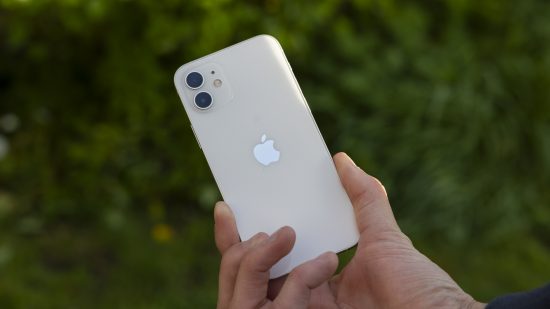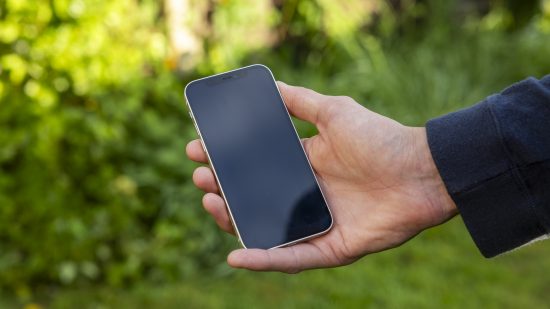Our Verdict
A reliable but ageing handset, Apple's iPhone 12 is a great budget option if you want a well-designed and capable iPhone for everyday apps and light gaming. The battery life and camera aren't market leading, but you get what you pay for, and the iPhone 12 is half the price of the latest flagships. Buy it if you like the Apple ecosystem and want value for money on your next smartphone.
The iPhone 12 was released as the vanilla model in Apple’s iPhone 12 lineup back in October 2020. It’s been superseded by the iPhone 13 and iPhone 14 and is likely to be pushed back a generation again by the launch of the rumored iPhone 15 this fall.
Despite its age, the iPhone 12 is still a great choice if you’re a casual gamer and don’t have the budget for the latest flagships. It’s more than half the price of the iPhone 14 Pro Max – for that, you get a beautiful design and 6.1-inch OLED display, plus Apple’s A14 Bionic chipset that breezes through everyday tasks. The iPhone 12 lineup was the first to get 5G connectivity, and it could still arguably sit among the best 5G phones on the market right now for sheer value for money.
The iPhone 12 is starting to show its age. Its camera tech specs are outdated, and the image quality is poles apart from the likes of the Google Pixel 7 Pro. Despite handling content well, it’s not a phone designed specifically for gaming, and it lacks a fast refresh screen or cooling mechanisms. Below, find out whether the iPhone 12 is still one of the best gaming iPhones you can buy today if you love Apple but don’t love the high price tag of the iPhone 14 lineup.
Pros
- Relatively affordable
- 5G coverage available
- Decent battery life
Cons
Price and availability
The iPhone 12 is still a good mid-range smartphone offered by some of the best cell phone providers. Given its age and mid-tier specs, monthly plans are much lower than the iPhone 14 and 13 series. You can pick up the iPhone 12 from major retailers like Walmart, Amazon, and Best Buy, but it’s getting harder to find a brand-new handset as many are now refurbished.
On the official Apple store, the iPhone 12 starts at $599. Apple also offers between $40-$640 if you trade in your old devices all the way to iPhone 7, which makes the deal even sweeter if you’re replacing an old iPhone.
Specs
Apple iPhone 12 specs:
| Display | 6.1-inch OLED (2532 x 1170 pixels) |
| CPU | A14 Bionic |
| Storage options | 64GB, 128GB, 256GB |
| Camera | Rear: 12MP wide (ƒ/1.6), 12MP ultrawide (ƒ/2.4) Front: 12MP (ƒ/2.2) |
| Battery capacity | 2,815 mAh |
| Dimensions | 5.78 x 2.81 x 0.29 inches |
| Weight | 5.78 ounces |
Features
Inside the iPhone 12 is Apple’s A14 bionic chip, now outdated by the A15 Bionic on the iPhone 14 and A16 on the iPhone 14 Pro models. As mentioned, it also has 5G and 4G connectivity, futureproofing you against upgrades to the network.
Thanks to MagSafe (magnets inside the phone) you can charge the iPhone easily with MagSafe-compatible chargers, giving you fast wireless charging up to 15W.
In terms of cameras, the iPhone 12 has a dual-camera system, offering wide and ultra-wide cameras to get more in the frame. Apple says that the power of the A14 Bionic chip improves computational photography; processing techniques that enhance the color and detail of your images. There’s more on how the camera performs in real-life scenarios below, but when it comes to video, iPhone 12 features 4K HDR recordings, plus the ability to edit these straight from the phone.
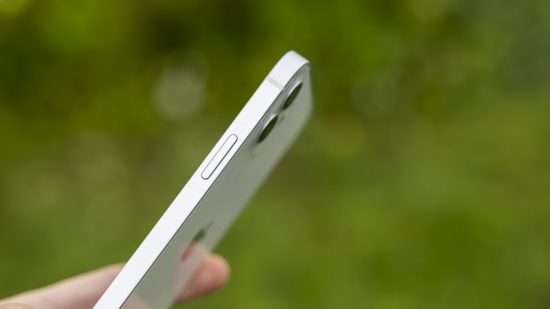
Design
Handling
The iPhone 12 is a sleek handset, with rounded corners and flat edges – a design that Apple carried through to the iPhone 13 and 14. While this approach looks aesthetically pleasing, offers greater durability, and allows solid buttons to sit on either side of the screen, the sharper edges can dig into your hands and make the phone harder to grip if you don’t use a phone case. Fortunately, a softer case does round off these edges, but it’s something to bear in mind if you like your phone case-free.
Display
The iPhone 12 has an edge-to-edge display (apart from the Face ID notch at the top) which means you get more display with less bulk. The iPhone 12 has a 6.1-inch OLED display with an 1170 x 2532 resolution. This maxes out at 60Hz, which is below the smooth refresh rate of the 120 Hz iPhone 14 Pro with ‘ProMotion’.
Despite that, the screen is vibrant, crisp, and gorgeous to look at, whether you’re web browsing, editing photos, or playing games. In sunshine, the 625 nits brightness can be a little lacking, but that’s my only real complaint.
Durability
The front case is built with Apple’s tough Ceramic Shield display, while the back is made from glass and aluminum. Unlike cheaper plastic constructions, the iPhone 12 build belies its price, feels premium, and overall sits nicely in the hand. It’s a good size for my smaller hands, which are dwarfed by the likes of the Google Pixel 7 Pro.
The iPhone 12 is available in black, white, (PRODUCT) RED, green, blue, and purple colorways – which provides plenty of options for the fashion-conscious among us. I’ve had the white version for over two years, and amazingly, I’ve yet to notice any major scratches either on the back casing or the screen itself – despite multiple drops out of my pocket onto hard surfaces.
With an IP68 rating, the iPhone 12 is splash and dust-resistant, but certainly nowhere near as hardy as the best rugged smartphones. It’s been out in the rain, on beaches, and in the mist, and has never faltered under these conditions.
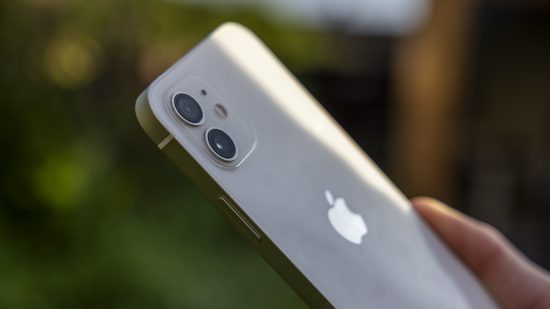
Cameras
The iPhone 12 has a dual 12-megapixel camera system and a front-facing selfie camera. Resolution isn’t everything, especially if you only ever post your photos to social media, but it’s worth comparing this count to the 48MP main camera found on the iPhone 14 Pro and 50MP on the Samsung Galaxy S23. When you use the digital zoom (up to 5x zoom) on the iPhone 12m there’s effectively less picture to crop in on, and the quality is poorer.
Portrait mode was first introduced to the iPhone in 2016, but it gets better with each new iteration. With portrait mode activated on my iPhone 12, there’s a gorgeous bokeh effect behind the subject, and 9 times out of 10 it locks onto a subject quickly. After taking a photo, it’s easy to adjust the depth of field so that more or less of the image is sharp. You can also change the image lighting, including Natural, Studio, Contour, and Mono effects, although I generally find it more effective to edit photos manually. iOS provides all the parameters you’d expect, from contrast to white balance, but for inexperienced editors, Auto Edit does a good job most of the time.
I was impressed with the clarity and sharpness of the images from my iPhone 12 when I first bought it. However, several years later, having now reviewed hundreds of phones, the cracks are starting to show. In bright sunshine, images have a tendency to blow out (meaning the highlight areas lose detail and information). You can pull the exposure down by tapping on these bright areas on the screen and dragging them down with a finger, but this won’t come naturally to beginners.
The iPhone 12 struggles when capturing high-contrast scenes, such as a landscape at sunset, or when shooting into a bright sun. When you shoot in dim locations or at night, images are acceptable without using the flash, thanks to a wide, bright main aperture of ƒ/1.6 and the phone’s Night Mode (which activates automatically in low light). When you do use the flash, the colors are natural and true to life.
Elsewhere, the iPhone 12’s camera app has several options for creative imagery, including slow-mo, panorama (up to 63MP), and timelapse. Live Photo is another excellent feature, as it records 1.5 seconds before and after pressing the shutter. The upshot of this is that you can capture lots of silly and unplanned moments, and you can turn these live photos into GIFs or choose the best frame.
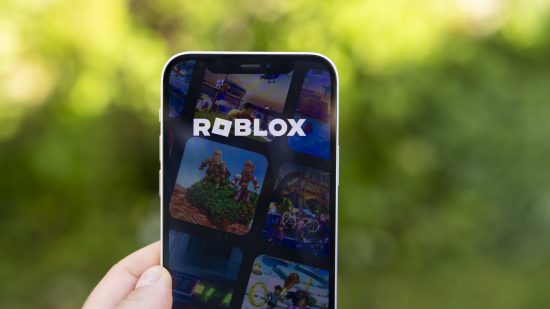
Battery life
The iPhone 12 has a 2,815 mAh battery, smaller than the iPhone 14 Phone’s 3,279 mAh but not by a significant amount. On a day when I’m working from home and using it during breaks, it lasts all day (around 16 hours) – with some juice to record an hour or so workout with music. When I’m traveling, using 5G, running maps and Spotify, and maybe playing Apple arcade games, I’d say the battery lasts more like 8 hours, needing a top-up from a public power outlet or iPhone power bank.
Phone batteries become less effective over time. After over two years of heavy use, my iPhone 12 battery is at 84 percent maximum capacity. When I played Roblox for 1 hour, the battery had drained by 20 percent.
Performance
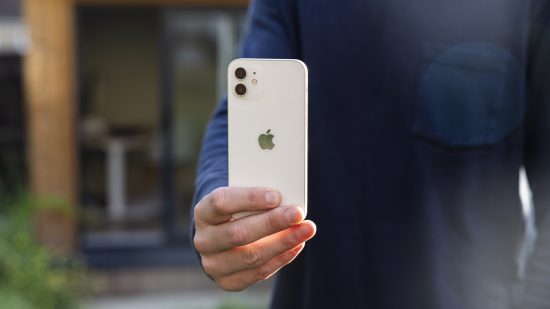
I’ll start by saying this: Apple iPhones are not specifically gaming phones. But that doesn’t mean you can’t have a great experience when using one, or that Apple isn’t marketing at gamers.
There aren’t any games I’ve struggled to play, although I do always make sure to shut down other power-hungry apps before launching them. I’ve tried Genshin Impact and Stardew Valley on the highest graphics settings and haven’t noticed any problems with the frame rate. In fact, the device consistently hits 60 fps playback and gives a smooth experience.
The iPhone 12’s chip with two high-performance cores can handle most programs I throw at it, including Adobe Lightroom and Photoshop for mobile. The only time I’ve ever found the iPhone 12 to crash is when it’s left in hot sunshine – but any device would likely do the same, and a quick spell in the shade returns it to normal.
The iPhone 12 comes with a 64 GB base level of storage. This is a pain point for me, as I quickly filled it within a few months with music, and photos and by downloading several games. If storing media is important to you, I’d recommend splashing out on the 128 GB or even 256 GB models so that your device will have capacity for some time to come.
Should you buy the iPhone 12?
- Yes: If you want an affordable and well-designed iPhone
- No: If you want the latest handset
- No: If you’re a hardcore gamer
If the iPhone 12 isn’t for you
If you’re after the fastest, latest Apple handset, then the iPhone 14 Pro is an excellent choice. It has a better display and cameras, but you’ll need a top-tier budget, given it retails for around $1,000 (£1,000).
Want a similarly affordable smartphone but prefer the Android operating system? The Google Pixel 7 is dependable and affordable.
Verdict
If you want an Apple smartphone for browsing the web, answering emails, and playing the odd game, the iPhone 12 is a brilliant choice. As a 5G phone, it’s futureproofed for the next few years of network connectivity, but at under $500, it won’t break the bank.
I’ve had the iPhone 12 for two years, and despite it being superseded several times by new iPhone generations, I’ve got no thoughts about updating it just yet. The iPhone 12 isn’t a media powerhouse, and its cameras are outdated by current standards, but for the current price, it’s hard to complain.
